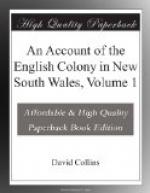CHAPTER XXIII
The Boddingtons and Sugar Cane sail
A mill erected
Thefts committed
Convicts emancipated
Two persons killed by lightning
The Fairy arrives
Farms sold
Public works
The Francis returns from New Zealand
The Fairy sails
Ration altered
Transactions
Harvest begun
Criminal Court held
A convict executed
Provisions
Mill at Parramatta
Christmas Day
Natives
Convicts
Boats
Grants of land
Settlers
Public works
Expenses how to be calculated
Deaths in 1793
Prices of grain, stock, and labour
October.] The Boddingtons and Sugar Cane being both bound for the same port in India (Bengal) the masters agreed to proceed together; and on the 13th, the Sugar Cane having set up her rigging, and hurried through such refitting as was indispensably necessary, both ships left the harbour with a fair wind, purposing to follow in the Atlantic’s track. The master of the Boddingtons was furnished by us with a copy of a chart made on board the Pitt Indiaman, and brought hither by the Britannia, of a passage or channel found by that ship in the land named by Lieutenant Shortland New Georgia; which channel was placed in the latitude of 8 degrees 30 minutes S and in the longitude of 158 degrees 30 minutes E and named ‘Manning’s Straits,’ from the commander of the Pitt.
The master of the Sugar Cane, had he been left to sail alone, determined to have tried the passage to India by the way of the South Cape of this country, instead of proceeding to the northward, and seemed not to have any doubt of meeting with favourable winds after rounding the cape. By their proceeding together, however, it remained yet to be determined, whether a passage to India round the South Cape of this country was practicable, and whether it would be a safer and a shorter route than one through Endeavour or Torres Strait, the practicability of which was likewise undetermined as to any knowledge which was had of it in this colony.
Seven persons whose terms of transportation had expired, were permitted to quit the colony in these ships, and the master of the Sugar Cane had shipped Benjamin Williams, the last of the Kitty’s people who remained undisposed of. One free woman, the wife of a convict, took her passage in the Sugar Cane.
Notwithstanding the facility with which passages from this place were procured (very little more being required by the masters than permission to receive them, and that the parties should find their own provisions) it was found after the departure of these ships that some convicts had, by being secreted on board, made their escape from the colony; and two men, whose terms as convicts had expired, were brought up from the Sugar Cane the day she sailed, having got on board without permission; for which the lieutenant-governor directed them to be punished with fifty lashes each, and sent up to Toongabbie.




